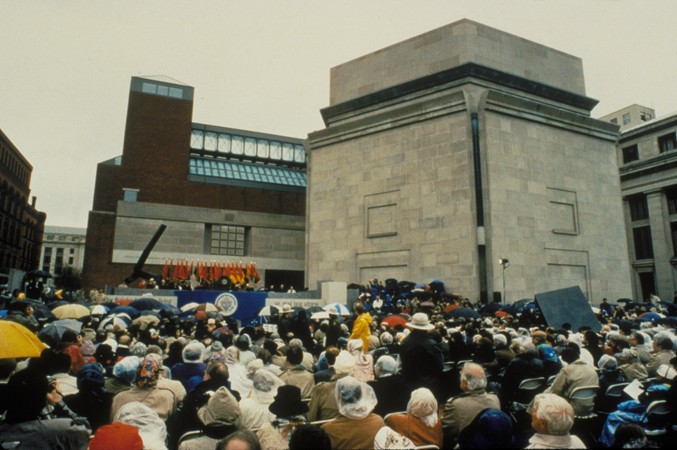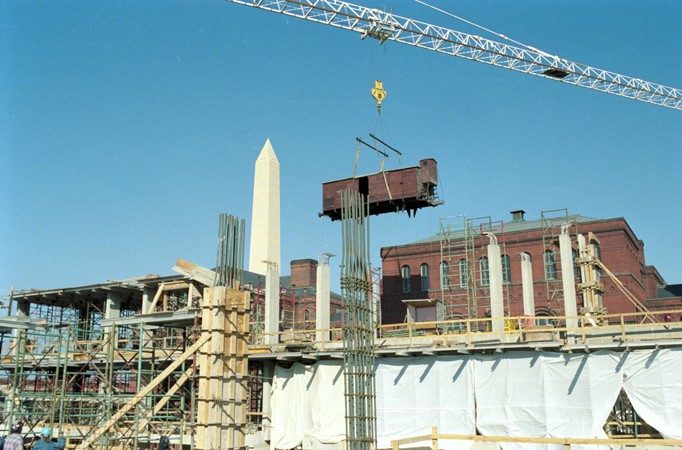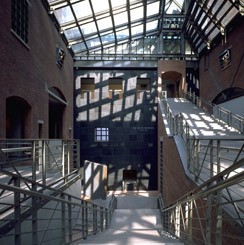
History of the United States Holocaust Memorial Museum
The United States Holocaust Memorial Museum is America’s national institution for the documentation, study, and interpretation of Holocaust history, and serves as this country’s memorial to the millions of people murdered during the Holocaust. It opened in April 1993.
The creation of the United States Holocaust Memorial Museum began as an idea in 1978. Transformed into reality, it has become an internationally recognized institution visited by nearly 2 million people annually.
President's Commission on the Holocaust
On November 1, 1978, President Jimmy Carter established the President's Commission on the Holocaust, chaired by author and Holocaust survivor Elie Wiesel. The Commission submitted a report to President Carter on September 27, 1979, recommending the establishment of a memorial with three main components: a national Holocaust memorial/museum, an educational foundation, and a Committee on Conscience. In 1980, the United States Congress unanimously voted to form the United States Holocaust Memorial Council. Its mandate was the creation of a living memorial to the 6 million Jews and millions of other victims who perished during the Holocaust.
Under Construction

The federal government made 1.9 acres of land adjacent to the National Mall in Washington available for the Museum site. The entire cost of construction—nearly $200 million—was paid for by private donations. During groundbreaking ceremonies on October 16, 1985, two milk cartons containing soil and ashes from a number of concentration camps and killing centers were buried on the site to symbolize the Museum's mission and the history it would convey.
One year later, 15th Street, which bordered one of the planned Museum's main entrances, was officially renamed Raoul Wallenberg Place—honoring the Swedish diplomat who led one of the most extensive and successful rescue efforts during the Holocaust.
In October 1988, President Ronald Reagan spoke at a special ceremony held when the cornerstone of the Museum was laid.
During the years of construction, which began in July 1989 and ended in April 1993, a vast amount of work had to be accomplished regarding the Museum's content. This work entailed extensive exhibition planning; artifact acquisition; designing every aspect of the Museum's Permanent Exhibition in a manner that both fulfilled the Museum's mission and presented Holocaust history in a truly educational, unfiltered manner; creating community programs; planning special exhibitions, and much more. The Museum's founding director, Jeshajahu (Shaike) Weinberg led this crucial exhibition planning phase and served as its director during the first stages of the Museum's daily operation.
Dedication and Mission
Dedication ceremonies for the Museum took place on April 22, 1993, and included speeches by President Bill Clinton; Chaim Herzog, president of Israel; Harvey Meyerhoff, chairman of the United States Holocaust Memorial Council; and Elie Wiesel, who had been awarded the Nobel Peace Prize in 1986. Several days later, on April 26, the Museum officially opened to the public. The first visitor was His Holiness the Dalai Lama of Tibet.
Soon after the opening, the Museum's Council—which remains as the Museum's governing body—adopted a mission statement that defined the work and the goals the Museum was committed to achieving and maintaining. In 1994, the Museum dedicated the plaza on Raoul Wallenberg Place to General Dwight David Eisenhower and the soldiers who fought under his command.
A Look Inside

The Museum building, which was designed by architect James Ingo Freed, contains permanent and temporary exhibition spaces; Remember the Children: Daniel's Story—an exhibition for children eight and older; an extensive research library and archives; two theaters; the Jack, Joseph and Morton Mandel Center for Advanced Holocaust Studies; the Children's Tile Wall; classrooms; the Hall of Witness; a memorial space, the Hall of Remembrance; and The Holocaust Survivors and Victims Resource Center.
The Permanent Exhibition The Holocaust spans three floors of the Museum building, and through historical documents, artifacts, photographs, film footage, historical and personal photographs, oral and video histories, and more, presents the full history of the Holocaust.
Special exhibitions presented by the Museum—in the Kimmel-Rowan Exhibition Gallery and in gallery space adjacent to the Gonda Education Center—provide compelling, detailed looks at special aspects of Holocaust history, and have included
- Americans and the Holocaust
- American Witnesses
- Some Were Neighbors: Collaboration & Complicity in the Holocaust
- State of Deception: The Power of Nazi Propaganda
- A Dangerous Lie: The Protocols of the Elders of Zion
- The Nazi Olympics: Berlin 1936
- Flight and Rescue
- Liberation
- The Hidden History of the Kovno Ghetto
- The Art and Politics of Arthur Szyk
- Nazi Persecution of Homosexuals 1933-1945;
- Fighting the Fires of Hate: America and the Nazi Book Burnings
- Anne Frank, the Writer: An Unfinished Story
- Life in Shadows: Hidden Children and the Holocaust
- Deadly Medicine: Creating the Master Race
New Chapter for Collections
In 2015, the Museum broke ground on the David and Fela Shapell Family Collections, Conservation, and Research Center, a state-of-the-art home for the Museum's collection of record on the Holocaust. The center serves as a hub of activity supporting acquisitions, education, and scholarship to ensure that future generations will continue to honor the memory of Holocaust victims and learn from their history to build a better future.
A Global Impact
Since the Museum's opening, traveling exhibitions, public programs, and Days of Remembrance commemorations have extended the reach of the institution's resources across the United States and abroad. In addition, the Museum's website provides a vast amount of content, including this Holocaust Encyclopedia, special focus pages about topics of current interest, access to the Museum's collections, and resources from the William Levine Family Institute for Holocaust Education and the Simon-Skjodt Center for the Prevention of Genocide.
Critical Thinking Questions
- Why is it important to remember the Holocaust?
- How does your country commemorate the Holocaust?

